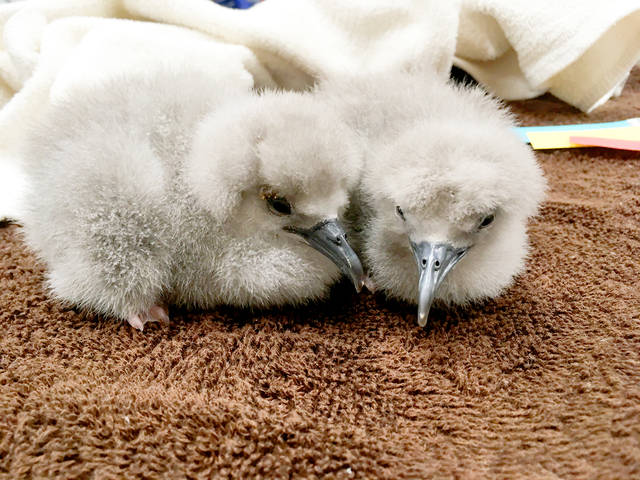LIHUE — Kauai is letting the moon take center stage once again as residents, businesses and organizations are dimming lights for the seabird fallout season.
At this time of year, native Hawaiian seabirds become disoriented by artificial lights during their maiden flights from their burrows out to sea, according to the state Department of Land and Natural Resources.
DLNR is encouraging people to adjust the lighting on their homes, businesses and organizations to accommodate for the birds from Sept. 15 through Dec. 15.
“Seabirds in particular have run into trouble when chicks take their first flight out to sea. As they rely on the light of the moon to guide them out to sea, they may be attracted to, and disoriented by onshore sources of man-made light,” said DLNR spokeswoman Deborah Ward in a press release.
It’s called “fallout” and it’s caused when seabirds circle artificial lights until they fall to the ground from exhaustion or from collisions with buildings or vehicles.
Once they’re grounded, the birds are at risk from cats, dogs and other predators. Vehicle collisions and starvation are also risks for the grounded birds, which are usually seen landing or sitting on roadways, in parking lots and on lawns.
The Pacific Missile Range Facility on the Westside is one of many organizations and entities that adjust their lights during the fallout-season in a program they call “Dark Skies.”
The program involves turning off all non-essential lighting on the base and modifying nighttime operations to help prevent fallout, said Robert Purdy, spokesman for PMRF.
Kauai Island Utility Cooperative also has a robust seabird fallout mitigation plan.
The organization has spent more than $26 million to date working to reduce the potential impact of utility structures and lights on Kauai’s protected and endangered seabirds, and works with the U.S. Fish and Wildlife Service and DLNR’s Division of Forestry and Wildlife to address the issues.
“Over the years, we have implemented numerous measures to reduce the potential impacts of our facilities on seabirds and to improve seabird survival and recovery,” KIUC’s transmission and distribution manager Carey Koide told TGI.
Changes to facilities include shielding thousands of streetlights, shielding facility lighting, undergrounding and altering power lines.
Projects to help improve seabird survival include funding, expanding and improving the Save Our Shearwaters (SOS) program, and funding habitat improvement projects.
SOS is located at Kauai Humane Society and is a rehabilitation and rescue facility for all of the island’s birds — including the endangered seabirds.
While some entities like KIUC and PMRF have their own plans for mitigating and preserving the island’s seabirds, the County of Kauai and the state’s DLNR-DOFAW are partnering with USFWS to create the Kauai Seabird Habitat Conservation Plan.
Meanwhile, translocation efforts for Hawaiian petrels and Newell’s shearwaters have been underway since 2015, with the goal of moving colonies from their predator-ridden mountain territories to predator-proof colonies within the Kilauea Point National Wildlife Reserve.
“Hawaiian seabirds have an important role to play on our islands,” Ward said.
Be a hero
Bring downed seabirds directly to the SOS shelter in Puhi, if possible during normal business hours. Downed seabirds can also be dropped off at public SOS aid stations, located at:
North: Kilauea Medical Group; Hanalei Fire Station (near Princeville shopping center); Hanalei Liquor Store
Central-East: Lihue Fire Station; Kapaa Fire Station; Kaiakea Fire Station; Kauai Humane Society
West: Waimea Fire Station; Hanapepe Fire Station; Kalaheo Fire Station
South: Koloa Fire Station
Simple steps
Anyone can help reduce the amount of birds that fall out from artificial lighting during this season by doing the following:
• Turn all outdoor lights so that they are facing down to the ground, and use downward lighting for signs;
• Turn off decorative and unnecessary lights as much as possible;
• Replace bare spotlights, floodlights, and unshielded lights with seabird friendly lighting styles (including shielding the lights to prevent them from facing upwards and using non-white or lower wattage lamps);
• Place floodlights and security lights on motion detectors so that they are not on all the time;
• Shield outdoor lights with commercially available or home-made glare reducing shields;
• Close curtains at night to help reduce overall glow and glare; and keep dogs and cats indoors so that they are not able to attack and kill grounded birds outside



Here we go again!
$26 Million dollars and more, that is an interesting figure. I hope they accomplish the organization’s objective. Really.
I’m with anybody. As long as a citizen you can properly convey your rebuttal when they put in another football player in as Lt. Governor. For the many and the proud people of Hawai’I.
Because that big guy is not my friend.
singing.